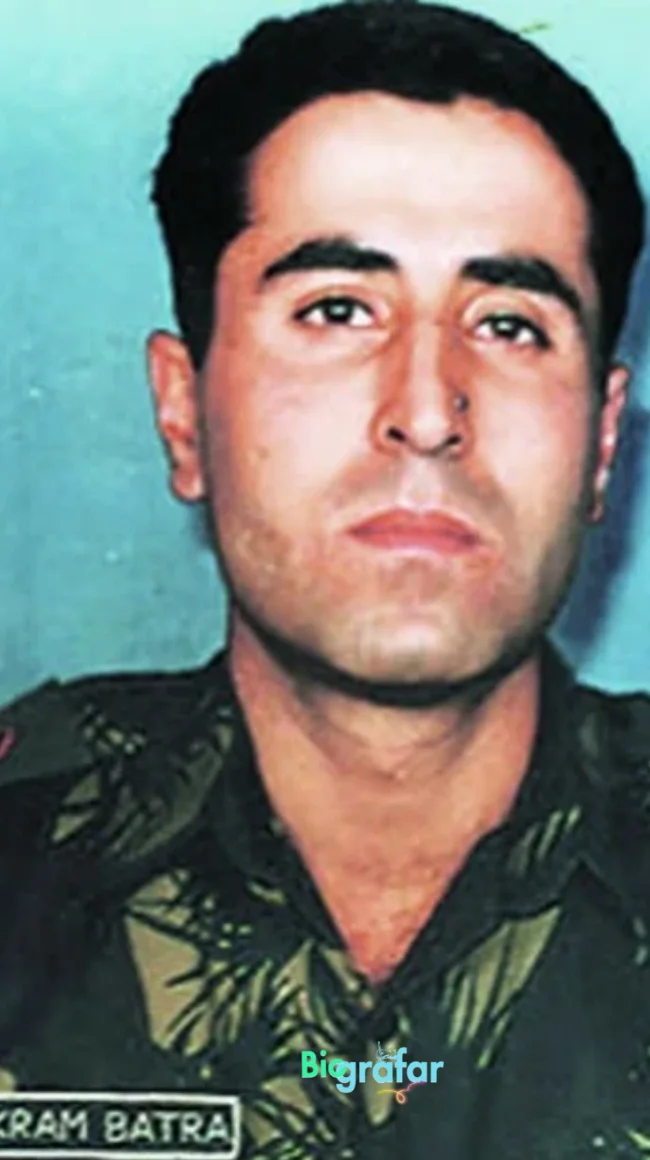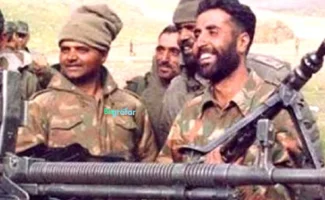Sher Shah of Kargil: Vikram Batra's Heroic Saga
Introduction
In the Indian military chronicles, Vikram Batra emerges as an enduring symbol of courage and selflessness. This narrative embarks on a journey through the remarkable life of this gallant soul, unraveling the layers of his formative years, military exploits, and the extraordinary heroism that unfolded amidst the challenging terrain of Kargil. As we delve into the annals of Vikram Batra’s life, his story unfolds not just as a military account but as a testament to the indomitable spirit that defines true heroes. From his early days shaping the essence of his character to the pivotal moments on the battlefield, the narrative captures the essence of a man whose actions echoed beyond the rugged mountains, leaving an indelible mark on the collective memory of a nation. Join us in exploring the profound legacy of Vikram Batra, where each chapter reveals a layer of sacrifice, determination, and unwavering dedication to the idea of duty that reverberates through the ages.
Vikram Batra's: Childhood Aspirations to Military Inspirations
Vikram Batra, born on September 9, 1974, in Palampur, Himachal Pradesh, exhibited early signs of valor and leadership. Raised in a family where academic dedication was instilled by his parents, Girdhari Lal Batra and Kamal Kanta Batra, Vikram embarked on a journey marked by courage and determination. As the elder twin, nicknamed 'Luv,' he received his primary education under his mother's guidance, attending D.A.V. Public School in Palampur.His educational pursuits continued at Central School in Palampur, where he not only excelled academically but also showcased his sporting prowess, representing the school at the national level in various competitions. Vikram's college days at DAV College, Chandigarh, saw him joining the Air Wing of the National Cadet Corps (NCC) and achieving accolades as the best NCC Air Wing cadet.In 1995, after completing his bachelor's degree, Vikram enrolled at Panjab University for an MA in English, concurrently preparing for the Combined Defence Services (CDS) Examination. His commitment to serving the nation led him to pass the CDS examination, securing a spot among the top 35 candidates. Following a successful interview at the Services Selection Board (SSB) in Allahabad, Vikram left his MA program to join the Indian Military Academy, driven by a desire to achieve something extraordinary for his country.This pivotal decision marked the beginning of Vikram Batra's military journey, setting the stage for his heroic legacy on the heights of Kargil.


Marching into Destiny: Vikram Batra's Call to Arms
Guided by an unwavering sense of duty and patriotism, Vikram Batra embarked on his military journey at the prestigious Indian Military Academy (IMA) in June 1996, joining the Manekshaw Battalion. This section delves into Batra’s training days, shedding light on the qualities that made him stand out among his peers and superiors. After a rigorous 19-month training course, he graduated from the IMA on December 6, 1997, receiving his commission as a lieutenant in the Indian Army. His initial posting was with the 13th battalion of the Jammu and Kashmir Rifles (13 JAK Rif) in Sopore, a region fraught with militant activity.
In Sopore, Batra faced multiple encounters with militants, showcasing his bravery and leadership. One notable incident involved an ambush in dense forest terrain, where he narrowly escaped a bullet meant for him, losing a comrade in the process. Undeterred, Batra led his men to eliminate the militants. His courage earned him respect and accolades.
Continuing his journey, Batra underwent a Commando Course in Belgaum, Karnataka, in January 1999, achieving the highest grading of Instructor’s Grade. Despite the challenges and dangers he faced, Batra maintained connections with his family regularly assuring them of his safety during phone calls.
As the tensions escalated in the Kargil region in June 1999, Batra’s battalion, originally destined for Shahjahanpur, Uttar Pradesh was rerouted to Dras. This shift marked the beginning of the Kargil War. Batra, now a Captain, communicated his movements to his family, offering reassurance. Unfortunately the last phone call on June 29, 1999, would be the final conversation between Batra and his mother, as he prepared to face the challenging terrain and adversities that awaited him in Dras.
Kargil Chronicles: Vikram Batra's Indomitable Spirit
In 1999, Vikram Batra's heroism reached its zenith during the Kargil War. This section unveils the events leading to the conflict, Batra's pivotal role, and the extraordinary courage that earned him the moniker "Sher Shah." Assigned to the 13 Jammu and Kashmir Rifles (13 JAK Rif), Batra's battalion was positioned in Dras on June 6, operating under the 56 Mountain Brigade. They received orders to act as reserves for the 2nd battalion of the Rajputana Rifles (2 Raj Rif) during the assault on Tololing mountain.The 18th battalion of The Grenadiers (18 Grenadiers) had previously attempted to capture Tololing, facing repeated setbacks and sustaining heavy casualties. Ultimately, on June 13, 1999, 2 Raj Rif successfully seized Tololing. Following this triumph, 13 JAK Rif, including Batra, embarked on a swift march from Dras to Tololing, reaching their destination in a mere 12 hours. Upon arrival, Alpha company of 13 JAK Rif took control of Tololing and a segment of the Hump Complex from 18 Grenadiers.Batra's Leadership & Tactical prowess came to the forefront during this phase, marking a turning point in the Kargil War. His strategic acumen and unwavering determination in the face of adversity played a crucial role in the success of the mission. As events unfolded on the challenging terrain of Tololing, Vikram Batra's heroism became a beacon of inspiration, setting the stage for further acts of valor in the days to come.
Remembering Our Hero: Captain Vikram Batra's Immortal Spirit
In the enduring echoes of time, Captain Vikram Batra’s legacy persists, transcending the years that have elapsed since his heroic sacrifice. This contemplative section delves into the profound impact of his gallantry, extending beyond the confines of the military realm and seamlessly weaving into the fabric of popular culture. Even as the sands of time shift, Batra’s heroism remains a poignant reminder of the indomitable spirit that defines the essence of his nation.
Batra’s influence extends into the realms of popular culture, where movies and books have become vessels to immortalize his compelling narrative. Beyond the military fraternity, his story resonates with a broader audience capturing the imagination of those who seek inspiration in tales of courage and selflessness. Through cinematic portrayals and literary renditions Vikram Batra’s journey from a small town to the forefront of the Kargil War has become a symbol of resilience, bravery and unwavering commitment.
His legacy lives on the annals of military history but also takes on a cultural significance that goes beyond the uniforms and battlefields. The silver screen has brought his narrative to life allowing audiences to witness the man behind the legend and understand the depth of his sacrifice. Books penned in his honor ensure that future generations inherit not just the story of a war hero but a timeless saga of valor.
Vikram Batra, the ‘Sher Shah,’ thus becomes more than a historical figure; he transforms into an enduring symbol, a beacon that guides and inspires. As we remember the Sher Shah, we acknowledge that his impact is not bound by time; it’s a legacy that continues to shape the narratives of bravery and sacrifice, transcending the boundaries of his earthly existence.
Heroic Echoes: Vikram Batra's Stand at Point 4875
In the tumultuous landscape of the Kargil War in 1999, Vikram Batra etched his name in history through his valor in the Battle of Point 4875. Tasked with capturing this strategically vital peak, Batra’s battalion faced the daunting challenge of neutralizing the enemy’s observation on National Highway 1. Major S Vijay Bhaskar and Lt. Col. Joshi meticulously planned the attack, and on July 2, the top military brass, including General Mohinder Puri, convened to finalize the strategy.
The 13 JAK Rifles, stationed 1500 meters from Point 4875, underwent extensive preparations, with artillery bombardment paving the way for the assault. The actual climb commenced at 2030 hours on July 4, led by ‘A’ and ‘C’ Companies. Despite Batra being unwell, his troops advanced, encountering enemy resistance and effective sniper fire.
As dawn broke on July 5, the Indian soldiers were 50 meters from their target, facing the challenge of daylight exposure. The commanding officer intervened, firing Fagot missiles to neutralize a strategically positioned enemy. The assault resumed, and by 1300 hours, Point 4875 was captured, but sporadic enemy artillery and machine-gun fire persisted.
The Indian victory expanded to ‘Area Flat Top,’ adjacent to Point 4875, contested in a seesaw battle. Captain NA Nagappa defended it fiercely, and when injured, Batra volunteered to reinforce. Leading a daring night climb with his Delta Company, Batra reached the top amid cheers from the beleaguered Indian soldiers. The battle intensified, with Batra personally neutralizing enemy positions and rescuing a wounded comrade.
The pinnacle of Batra’s heroism unfolded on July 7, as he led a daylight assault on an entrenched enemy on a narrow ledge. Despite sustaining severe injuries, Batra charged forward, uttering the battle cry of JAK RIF, “Durga mata ki jai.” Single-handedly eliminating multiple enemies, he secured a foothold on the ledge. In the decisive moments, Batra, valiant but fatally wounded, succumbed to the injuries, leaving an indelible mark on the annals of military history.
Eternal Courage: Vikram Batra's Legacy Beyond the Battlefields
Captain Vikram Batra's sacrificial valor resonates as an indelible mark of bravery and leadership. In the face of the enemy during the Kargil War, he exemplified the epitome of personal courage and dedication, ultimately making the supreme sacrifice in adherence to the highest traditions of the Indian Army.Recognizing his exceptional courage, Captain Vikram Batra was posthumously awarded the Param Vir Chakra, India's highest military honor, on August 15, 1999. This significant accolade, bestowed on the 52nd anniversary of India's independence, symbolizes the nation's utmost respect for his unparalleled contributions and sacrifice.The Param Vir Chakra citation aptly describes Captain Batra's conspicuous bravery and exceptional leadership in the heat of battle. His unwavering commitment to the mission and his men set a remarkable standard, reflecting the true spirit of heroism. In bestowing this honor, the nation acknowledged his selfless dedication and the sacrifice he made for the greater good.On that poignant day, Captain Batra's father G.L. Batra, stood as a representative of his departed son to receive the Param Vir Chakra from the President of India, the late K. R. Narayanan. The solemn ceremony marked a poignant moment where the nation expressed its gratitude and profound respect for the bravery and sacrifice of Captain Vikram Batra immortalizing his legacy in the annals of India's military history. His heroic actions continue to inspire generations and the Param Vir Chakra stands as a perpetual symbol of his extraordinary courage and commitment.